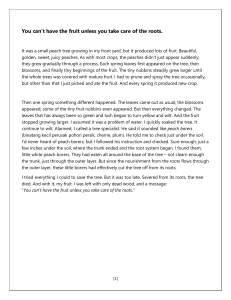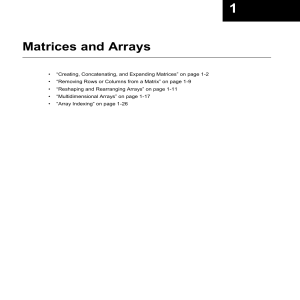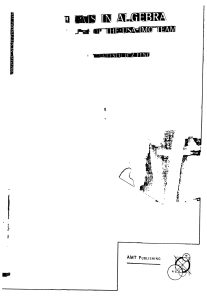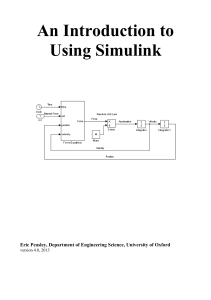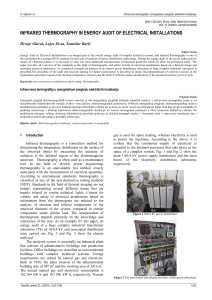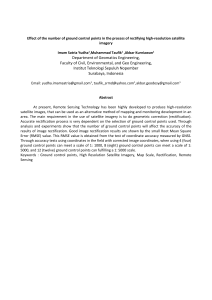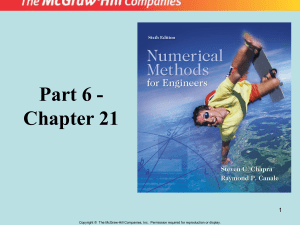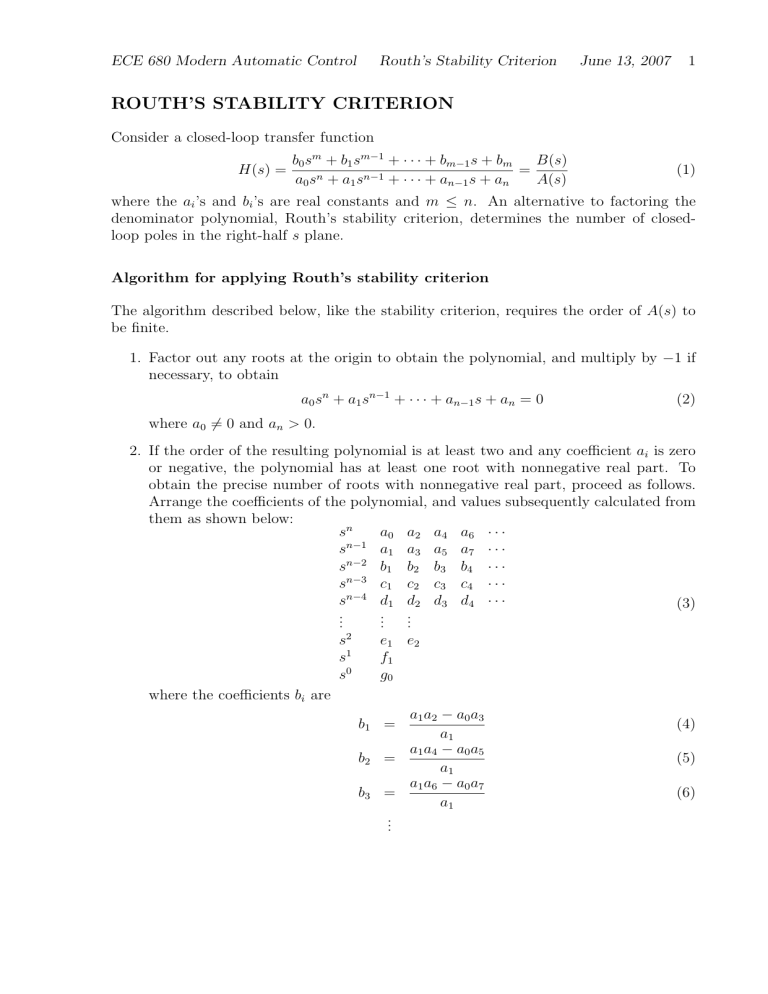
ECE 680 Modern Automatic Control Routh’s Stability Criterion June 13, 2007 1 ROUTH’S STABILITY CRITERION Consider a closed-loop transfer function H(s) = b0 sm + b1 sm−1 + · · · + bm−1 s + bm B(s) = a0 sn + a1 sn−1 + · · · + an−1 s + an A(s) (1) where the ai ’s and bi ’s are real constants and m ≤ n. An alternative to factoring the denominator polynomial, Routh’s stability criterion, determines the number of closedloop poles in the right-half s plane. Algorithm for applying Routh’s stability criterion The algorithm described below, like the stability criterion, requires the order of A(s) to be finite. 1. Factor out any roots at the origin to obtain the polynomial, and multiply by −1 if necessary, to obtain a0 sn + a1 sn−1 + · · · + an−1 s + an = 0 (2) where a0 6= 0 and an > 0. 2. If the order of the resulting polynomial is at least two and any coefficient ai is zero or negative, the polynomial has at least one root with nonnegative real part. To obtain the precise number of roots with nonnegative real part, proceed as follows. Arrange the coefficients of the polynomial, and values subsequently calculated from them as shown below: sn a0 a2 a4 a6 · · · n−1 s a1 a3 a5 a7 · · · sn−2 b1 b2 b3 b4 · · · sn−3 c1 c2 c3 c4 · · · sn−4 d1 d2 d3 d4 · · · (3) .. .. .. . . . 2 s e1 e2 1 s f1 s0 g0 where the coefficients bi are a1 a2 − a0 a3 (4) b1 = a1 a1 a4 − a0 a5 b2 = (5) a1 a1 a6 − a0 a7 (6) b3 = a1 .. . ECE 680 Modern Automatic Control Routh’s Stability Criterion June 13, 2007 2 generated until all subsequent coefficients are zero. Similarly, cross multiply the coefficients of the two previous rows to obtain the ci , di , etc. b 1 a3 − a1 b 2 b1 b 1 a5 − a1 b 3 = b1 b 1 a7 − a1 b 4 = b1 .. . c 1 b2 − b1 c 2 = c1 c 1 b3 − b1 c 3 = c1 .. . c1 = (7) c2 (8) c3 d1 d2 (9) (10) (11) until the nth row of the array has been completed1 Missing coefficients are replaced by zeros. The resulting array is called the Routh array. The powers of s are not considered to be part of the array. We can think of them as labels. The column beginning with a0 is considered to be the first column of the array. The Routh array is seen to be triangular. It can be shown that multiplying a row by a positive number to simplify the calculation of the next row does not affect the outcome of the application of the Routh criterion. 3. Count the number of sign changes in the first column of the array. It can be shown that a necessary and sufficient condition for all roots of (2) to be located in the left-half plane is that all the ai are positive and all of the coefficients in the first column be positive. Example: Generic Quadratic Polynomial. Consider the quadratic polynomial: a0 s 2 + a1 s + a2 = 0 (12) where all the ai are positive. The array of coefficients becomes s 2 a0 a2 s 1 a1 0 s 0 a2 1 (13) There is one important detail that we have not yet mentioned. If an element of the first column becomes zero, we must alter the procedure. Since this altered procedure is requires some explanation, we postpone discussion of it to a pair of subsections below. ECE 680 Modern Automatic Control Routh’s Stability Criterion June 13, 2007 3 where the coefficient a1 is the result of multiplying a1 by a2 and subtracting a0 (0) then dividing the result by a2 . In the case of a second order polynomial, we see that Routh’s stability criterion reduces to the condition that all ai be positive. Example: Generic Cubic Polynomial. Consider the generic cubic polynomial: a0 s3 + a1 s2 + a2 s + a3 = 0 (14) where all the ai are positive. The Routh array is s3 s2 s1 s0 a0 a1 a2 a3 a1 a2 −a0 a3 a1 (15) a3 so the condition that all roots have negative real parts is a1 a2 > a 0 a3 . (16) Example: A Quartic Polynomial. Next we consider the fourth-order polynomial: s4 + 2s3 + 3s2 + 4s + 5 = 0. (17) Here we illustrate the fact that multiplying a row by a positive constant does not change the result. One possible Routh array is given at left, and an alternative is given at right, s4 s3 1 3 5 2 4 0 s2 1 5 s1 −6 s0 5 s4 s3 s2 s1 s0 1 62 1 1 −3 5 3 5 6 4 6 0 Divide this row by two to get 2 0 5 In this example, the sign changes twice in the first column so the polynomial equation A(s) = 0 has two roots with positive real parts. Necessity of all coefficients being positive. In stating the algorithm above, we did not justify the stated conditions. Here we show that all coefficients being positive is necessary for all roots to be located in the left halfplane. It can be shown that any polynomial in s, all of whose coefficients are real, can ECE 680 Modern Automatic Control Routh’s Stability Criterion June 13, 2007 4 be factored into a product of a maximal number linear and quadratic factors also having real coefficients. Clearly a linear factor (s + a) has nonnegative real root iff a is positive. For both roots of a quadratic factor (s2 + bs + c) to have negative real parts both b and c must be positive. (If c is negative, the square root of b2 − 4c is real and the quadratic factor can be factored into two linear factors so the number of factors was not maximal.) It is easy to see that if all coefficients of the factors are positive, those of the original polynomial must be as well. To see that the condition is not sufficient, we can refer to several examples above. Example: Determining Acceptable Gain Values So far we have discussed only one possible application of the Routh criterion, namely determining the number of roots with nonnegative real parts. In fact, it can be used to determine limits on design parameters, as shown below. Consider a system whose closed-loop transfer function is H(s) = s(s2 K . + s + 1)(s + 2) + K (18) The characteristic equation is s4 + 3s3 + 3s2 + 2s4 + K = 0. (19) s4 1 3 K 3 s 3 2 0 s2 7/3 K s1 2 − 9K/7 s0 K (20) The Routh array is so the s1 row yields the condition that, for stability, 14/9 > K > 0. (21) Special Case: Zero First-Column Element. If the first term in a row is zero, but the remaining terms are not, the zero is replaced by a small, positive value of and the calculation continues as described above. Here’s an example: s3 + 2s2 + s + 2 = 0 (22) has Routh array s3 1 1 2 s 2 2 s1 0 ∼ = s0 2 (23) ECE 680 Modern Automatic Control Routh’s Stability Criterion June 13, 2007 5 where the last element of the first column is equal 2 = (2 − 0)/. In counting changes of sign, the row beginning with is not counted. If the elements above and below the in the first column have the same sign, a pair of imaginary roots is indicated. Here, for example, (22) has two roots at s = ±j. On the other hand, if the elements above and below the have opposite signs, this counts as a sign change. For example, s3 − 3s + 2 = (s2 − 1)(s + 2) = 0 (24) s3 1 −3 s2 0∼ 2 = 1 s −3 − 2/ s0 2 (25) has Routh array with two sign changes in the first column. Special Case: Zero Row. If all the coefficients in a row are zero, a pair of roots of equal magnitude and opposite sign is indicated. These could be two real roots with equal magnitudes and opposite signs or two conjugate imaginary roots. The zero row is replaced by taking the coefficients of dP (s)/ds, where P (s), called the auxiliary polynomial, is obtained from the values in the row above the zero row. The pair of roots can be found by solving dP (s)/ds = 0. Note that the auxiliary polynomial always has even degree. It can be shown that an auxiliary polynomial of degree 2n has n pairs of roots of equal magnitude and opposite sign. Example: Use of Auxiliary Polynomial Consider the quintic equation A(s) = 0 where A(s) is s5 + 2s4 + 24s3 + 48s2 − 50. (26) s5 1 24 −25 s4 2 48 −50 ←− auxiliary polynomial P (s) s3 0 0 (27) The Routh array starts off as The auxiliary polynomial P (s) is P (s) = 2s4 + 48s2 − 50 (28) which indicates that A(s) = 0 must have two pairs of roots of equal magnitude and opposite sign, which are also roots of the auxiliary polynomial equation P (s) = 0. Taking ECE 680 Modern Automatic Control Routh’s Stability Criterion June 13, 2007 6 the derivative of P (s) with respect to s we obtain dP (s) = 8s3 + 96s. ds (29) so the s3 row is as shown below and the Routh array is s5 1 24 −25 s4 2 48 −50 3 s 8 96 ←− Coefficients of dP (s)/ds 2 s 24 −50 s1 112.7 0 0 s −50 (30) There is a single change of sign in the first column of the resulting array, indicating that there A(s) = 0 has one root with positive real part. Solving the auxiliary polynomial equation, 2s4 + 48s2 − 50 = 0 (31) yields the remaining roots, namely, from s2 = 1, s2 = −25, (32) s = ±1, s = ±j5. (33) so the original equation can be factored as (s + 1)(s − 1)(s + j5)(s − j5)(s + 2) = 0. (34) Relative stability analysis. Routh’s stability criterion provides the answer to the question of absolute stability. This, in many practical cases, is not sufficient. We usually require information about the relative stability of the system. A useful approach for examining relative stability is to shift the s-plane axis and apply Routh’s stability criterion. Namely, we substitute s = z − σ (σ = constant) into the characteristic equation of the system, write the polynomial in terms of z, and apply Routh’s stability criterion to the new polynomial in z. The number of changes of sign in the first column of the array developed for the polynomial in z is equal to the number of roots which are located to the right of the vertical line s = −σ. Thus, this test reveals the number of roots which lie to the right of the vertical line s = −σ. 2 2 This italicized text and most of the numerical examples are from Section 6-6 of Ogata, Katsuhiko, Modern Control Engineering, Englewood Cliffs, NJ: Prentice-Hall, 1970, pp. 252–258. The rest of the text, including the descriptions of the examples is mine.

